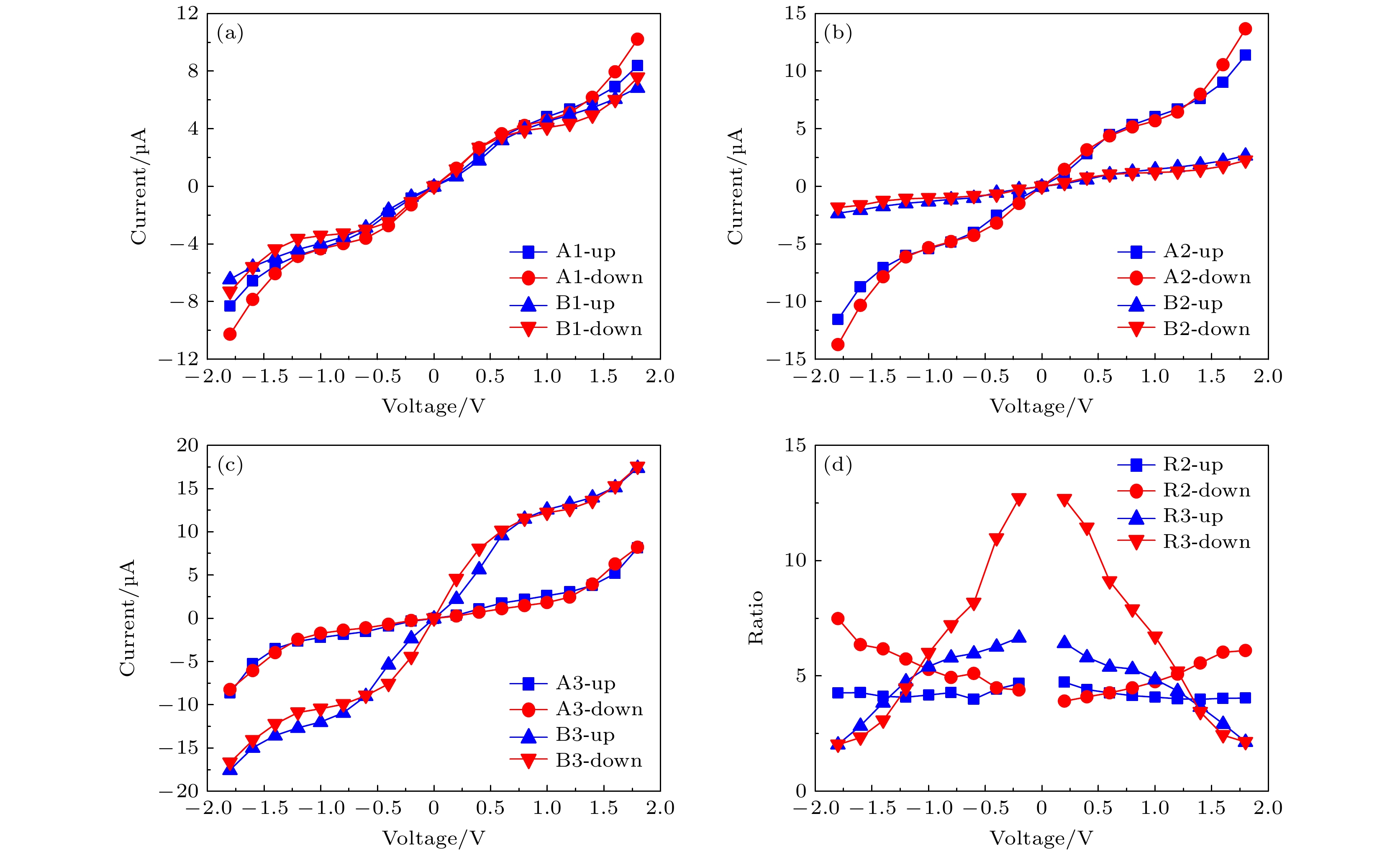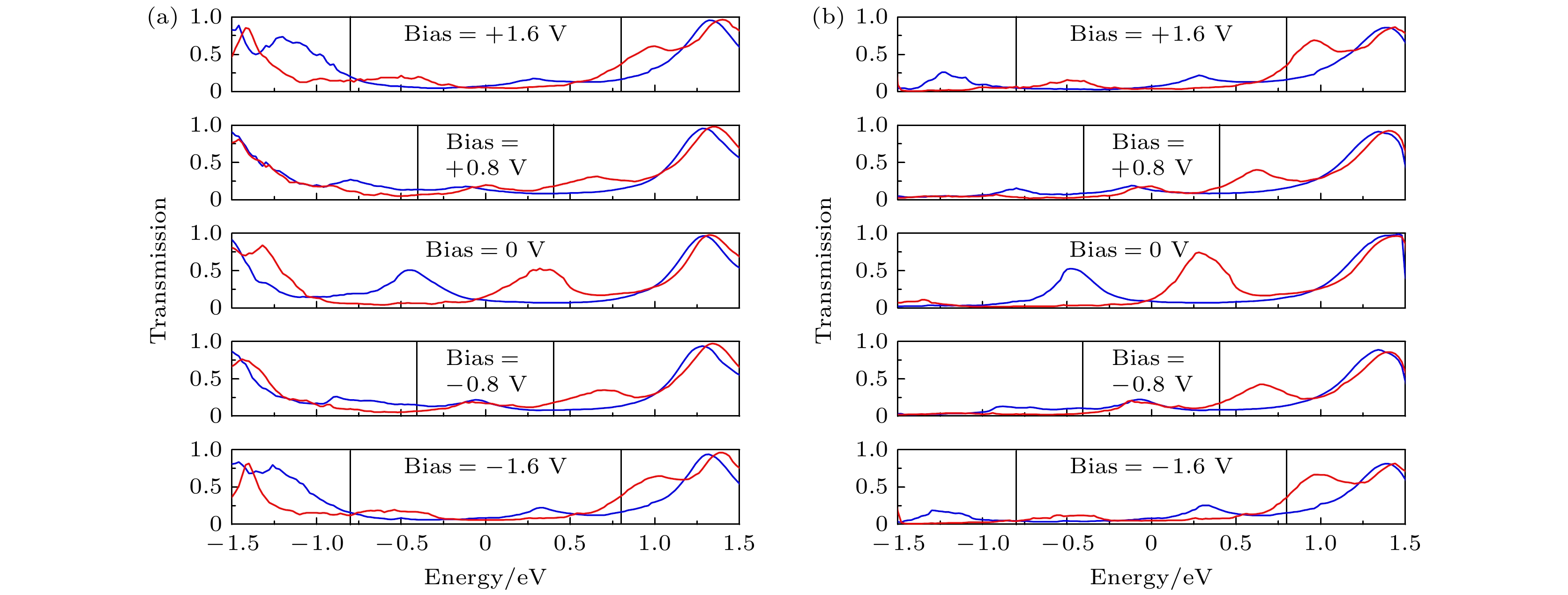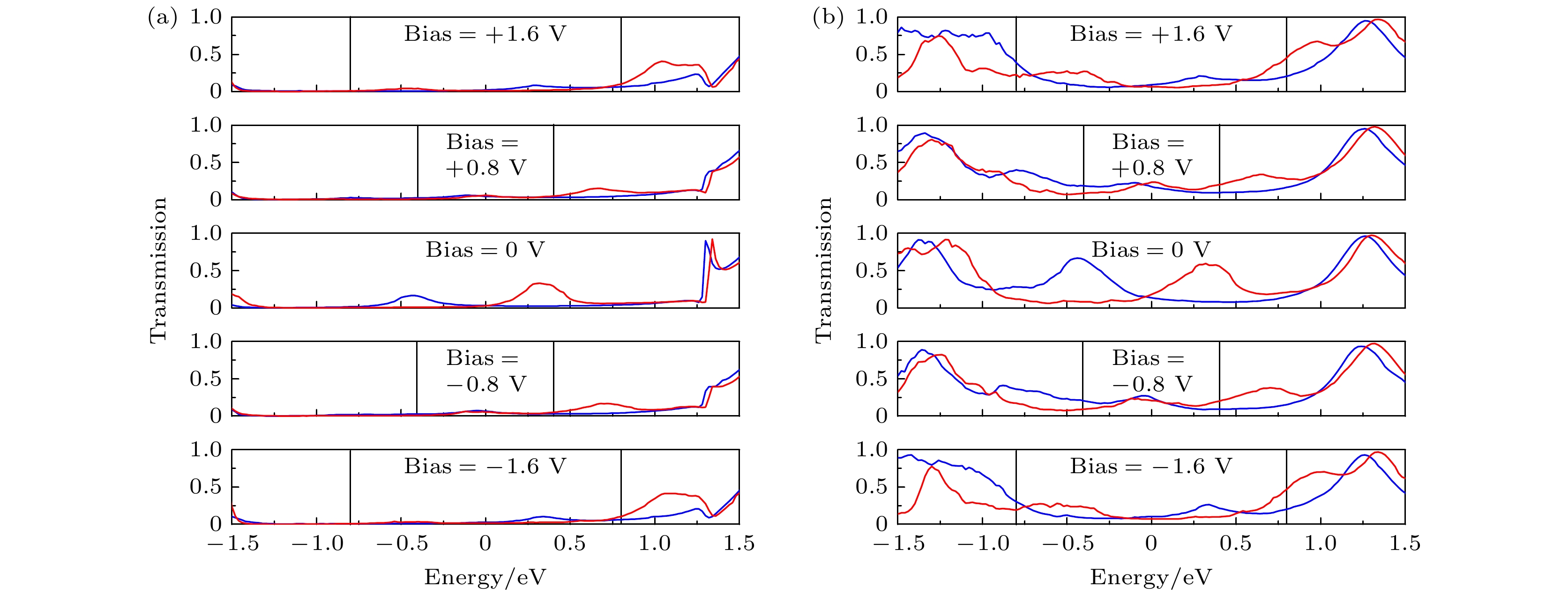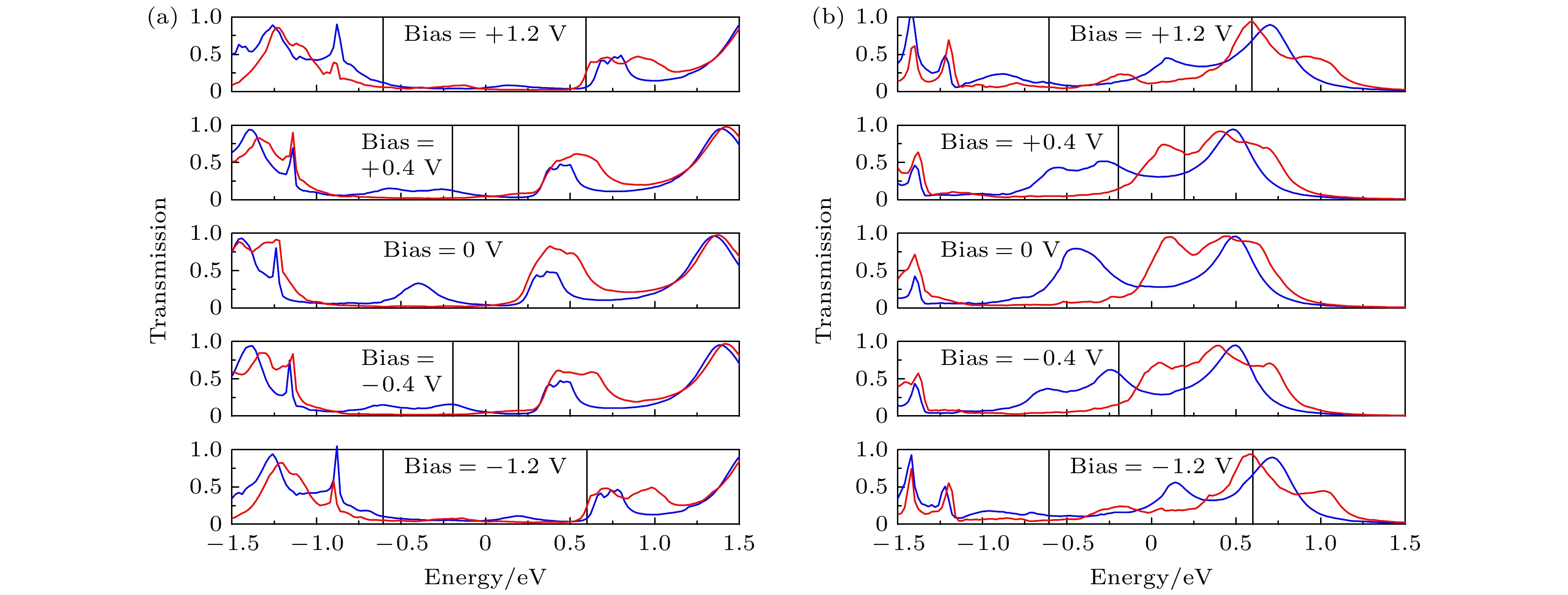-
Previous research results show that the conductance difference in molecular junction caused by quantum interference (QI) effect is an important way to identify isomers or improve the recognition sensitivity. Recently, single-molecule conductance of two fully π-conjugated dithienoborepin (DTB) isomers (DTB-A and DTB-B) with tricoordinate boron centers has been measured by using the scanning tunneling microscopy break junction technique. The result shows that QI can enhance chemical responsivity in single-molecule DTB junction. In this work, the first-principles method based on density functional theory and non-equilibrium Green's function is used to study the influence of QI effect on spin-transport property of DTB molecular junction connected to the nickel electrode, and the purpose of distinguishing DTB isomers (DTB-A and DTB-B) is realized by using amino and nitro passivation. The results show that the pristine DTB-A molecule and DTB-B molecule both have a up-spin transmission peak dominated by HOMO and a down-spin transmission peak dominated by LUMO on both sides of the Fermi level, and the energy positions and coefficients of two transmission peaks are basically the same. Therefore, the up-spin and down-spin current curves of the two junctions basically coincide, so that it is impossible to clearly distinguish the two isomers of DTB molecule simply by spin current. The QI can enhance the spin-polarized transport capability of two orbitals of amino-passivated DTB-A molecule to varying degrees but weaken the spin-polarized transport capability of two orbitals of amino-passivated DTB-B molecule. Therefore, the current of DTB-A molecular junction passivated by amino group is always higher than that of DTB-B molecular junction passivated by amino group. However, the QI can greatly enhance the spin-polarized transport capability of two orbitals of nitro-passivated DTB-B molecule but weaken the spin-polarized transport capability of two orbitals of nitro-passivated DTB-A molecule. Therefore, the current of DTB-B molecular junction passivated by nitro is always higher than that of DTB-A molecular junction passivated by nitro. Because the QI has different effects on the spin-transport capability of DTB-A and DTB-B passivated by amino or nitro group, so the two isomers of DTB molecule can be distinguished by measuring the spin current value. The above conclusions provide more theoretical guidance for the practical preparation of spin molecular junctions and the regulation of their spin-transport performance in the future.
-
Keywords:
- first principles /
- density functional theory /
- molecular device /
- quantum interference /
- spin-transport
[1] Aviram A, Ratner M A 1974 Chem. Phys. Lett. 29 277
 Google Scholar
Google Scholar
[2] Perrin M L, Frisenda R, Koole M, Seldenthuis J S, Gil J A C, Valkenier H, Hummelen J C, Renaud N, Grozema F C, Thijssen J M, Dulić D, van der Zant H S J 2014 Nat. Nanotechnol. 9 830
 Google Scholar
Google Scholar
[3] Koley S, Chakrabarti S 2018 Chem. Eur. J. 24 5876
 Google Scholar
Google Scholar
[4] Sharma P, Bernard L S, Bazigos A, Magrez A, Ionescu A M 2015 ACS Nano 9 620
 Google Scholar
Google Scholar
[5] Kumar S, Wang Z, Davila N, Kumari N, Norris K J, Huang X, Strachan J P, Vine D, Kilcoyne A L D, Nishi Y, Williams R S 2017 Nat. Commun. 8 658
 Google Scholar
Google Scholar
[6] Li Z L, Sun F, Bi J J, Liu R, Suo Y Q, Fu H Y, Zhang G P, Song Y Z, Wang D, Wang C K 2019 Physica E 106 270
 Google Scholar
Google Scholar
[7] Liu Q, Li J J, Wu D, Deng X Q, Zhang Z H, Fan Z Q, Chen K Q 2021 Phys. Rev. B 104 045412
 Google Scholar
Google Scholar
[8] Komeda J, Takada K, Maeda H, Fukui N, Tsuji T, Nishihara H 2022 Chem. Eur. J. 28 e202201316
 Google Scholar
Google Scholar
[9] Zhao J, Zeng H, Wang D, Yao G 2020 Appl. Surf. Sci. 519 146203
 Google Scholar
Google Scholar
[10] Petersen M Å, Rasmussen B, Andersen N N, Sauer S P A, Nielsen M B, Beeren S R, Pittelkow M 2017 Chem. Eur. J. 23 17010
 Google Scholar
Google Scholar
[11] Fan Z Q, Zhang Z H, Yang S Y 2020 Nanoscale 12 21750
 Google Scholar
Google Scholar
[12] Jiang J, Kula M, Lu W, Luo Y 2005 Nano Lett. 5 1551
 Google Scholar
Google Scholar
[13] Lambert C J 2015 Chem. Soc. Rev. 44 875
 Google Scholar
Google Scholar
[14] Gehring P, Thijssen J M, van der Zant H S J 2019 Nat. Rev. Phys. 1 381
 Google Scholar
Google Scholar
[15] Manrique D Z, Huang C, Baghernejad M, Zhao X, Al-Owaedi O A, Sadeghi H, Kaliginedi V, Hong W, Gulcur M, Wandlowski T, Bryce M R, Lambert C J 2015 Nat. Commun. 6 6389
 Google Scholar
Google Scholar
[16] Fan Z Q, Sun W Y, Zhang Z H, Deng X Q, Tang G P, Xie H Q 2017 Carbon 122 687
 Google Scholar
Google Scholar
[17] Li Z L, Bi J J, Liu R, Yi X H, Fu H Y, Sun F, Wei M Z, Wang C K 2017 Chin. Phys. B 26 098508
 Google Scholar
Google Scholar
[18] Yang Y, Gantenbein M, Alqorashi A, Wei J, Sangtarash S, Hu D, Sadeghi H, Zhang R, Pi J, Chen L, Huang X, Li R, Liu J, Shi J, Hong W, Lambert C J, Bryce M R 2018 J. Phys. Chem. C 122 14965
 Google Scholar
Google Scholar
[19] Liu X, Sangtarash S, Reber D, Zhang D, Sadeghi H, Shi J, Xiao Z Y, Hong W, Lambert C J, Liu S X 2017 Angew. Chem. 129 179
 Google Scholar
Google Scholar
[20] Borges A, Fung E D, Ng F, Venkataraman L, Solomon G C 2016 J. Phys. Chem. Lett. 7 4825
 Google Scholar
Google Scholar
[21] Frisenda R, Janssen V A E C, Grozema F C, van der Zant H S J, Renaud N 2016 Nat. Chem. 8 1099
 Google Scholar
Google Scholar
[22] Liu R, Bi J J, Xie Z, Yin K, Wang D, Zhang G P, Xiang D, Wang C K, Li Z L 2018 Phys. Rev. Appl. 9 054023
 Google Scholar
Google Scholar
[23] Zhang Y P, Chen L C, Zhang Z Q, Cao J J, Tang C, Liu J, Duan L L, Huo Y, Shao X, Hong W, Zhang H L 2018 J. Am. Chem. Soc. 140 6531
 Google Scholar
Google Scholar
[24] Yang G, Sangtarash S, Liu Z, Li X, Sadeghi H, Tan Z, Li R, Zheng J, Dong X, Liu J, Yang Y, Shi J, Xiao Z, Zhang G, Lambert C, Hong W, Zhang D 2017 Chem. Sci. 8 7505
 Google Scholar
Google Scholar
[25] Li Y, Buerkle M, Li G, Rostamian A, Wang H, Wang Z, Bowler D R, Miyazaki T, Xiang L, Asai Y, Zhou G, Tao N 2019 Nat. Mater. 18 357
 Google Scholar
Google Scholar
[26] Huang B, Liu X, Yuan Y, Hong Z W, Zheng J F, Pei L Q, Shao Y, Li J F, Zhou X S, Chen J Z, Jin S, Mao B W 2018 J. Am. Chem. Soc. 140 17685
 Google Scholar
Google Scholar
[27] Bai J, Daaoub A, Sangtarash S, Li X, Tang Y, Zou Q, Sadeghi H, Liu S, Huang X, Tan Z, Liu J, Yang Y, Shi J, Mészáros G, Chen W, Lambert C, Hong W 2019 Nat. Mater. 18 364
 Google Scholar
Google Scholar
[28] Zheng J, Liu J, Zhuo Y, Li R, Jin X, Yang Y, Chen Z B, Shi J, Xiao Z, Hong W, Tian Z Q 2018 Chem. Sci. 9 5033
 Google Scholar
Google Scholar
[29] Liu J, Zhao X, Al-Galiby Q, Huang X, Zheng J, Li R, Huang C, Yang Y, Shi J, Manrique D Z, Lambert C J, Bryce M R, Hong W 2017 Angew. Chem. 129 13241
 Google Scholar
Google Scholar
[30] Cai S, Deng W, Huang F, Chen L, Tang C, He W, Long S, Li R, Tan Z, Liu J, Shi J, Liu Z, Xiao Z, Zhang D, Hong W 2019 Angew. Chem. Int. Ed. 58 3829
 Google Scholar
Google Scholar
[31] Ozawa H, Baghernejad M, Al-Owaedi O A, Kaliginedi V, Nagashima T, Ferrer J, Wandlowski T, García-Suárez V M, Broekmann P, Lambert C J, Haga M A 2016 Chem. Eur. J. 22 12732
 Google Scholar
Google Scholar
[32] Greenwald J E, Cameron J, Findlay N J, Fu T, Gunasekaran S, Skabara P J, Venkataraman L 2021 Nat. Nanotechnol. 16 313
 Google Scholar
Google Scholar
[33] Trasobares J, Vuillaume D, Théron D, Clément N 2016 Nat. Commun. 7 12850
 Google Scholar
Google Scholar
[34] Niu L L, Fu H Y, Suo Y Q, Liu R, Sun F, Wang S S, Zhang G P, Wang C K, Li Z L 2021 Phys. E 128 114542
 Google Scholar
Google Scholar
[35] Wu D, Huang L, Jia P Z, Cao X H, Fan Z Q, Zhou W X, Chen K Q 2021 Appl. Phys. Lett. 119 063503
 Google Scholar
Google Scholar
[36] Fan Z Q, Xie F, Jiang X W, Wei Z, Li S S 2016 Carbon 110 200
 Google Scholar
Google Scholar
[37] Kushmerick J 2009 Nature 462 994
 Google Scholar
Google Scholar
[38] Richter S, Mentovich E, Elnathan R 2018 Adv. Mater. 30 1706941
 Google Scholar
Google Scholar
[39] Liu R, Han Y, Sun F, Khatri G, Kwon J, Nickle C, Wang L, Wang C K, Thompson D, Li Z L, Nijhuis C A, del Barco E 2022 Adv. Mater. 34 2202135
 Google Scholar
Google Scholar
[40] Fan Z Q, Sun W Y, Jiang X W, Zhang Z H, Deng X Q, Tang G P, Xie H Q, Long M Q 2017 Carbon 113 18
 Google Scholar
Google Scholar
[41] Zhou Q, Yang Y, Ni J, Li Z, Zhang Z 2010 Nano Res. 3 423
 Google Scholar
Google Scholar
[42] Baghernejad M, Van Dyck C, Bergfield J, Levine D R, Gubicza A, Tovar J D, Calame M, Broekmann P, Hong W 2019 Chem. Eur. J. 25 15141
 Google Scholar
Google Scholar
[43] Büttiker M, Imry Y, Landauer R, Pinhas S 1985 Phys. Rev. B 31 6207
 Google Scholar
Google Scholar
[44] Smidstrup S, Markussen T, Vancraeyveld P, Wellendorff J, Schneider J, Gunst T, Verstichel B, Stradi D, Khomyakov P A, Vej-Hansen U G, Lee M E, Chill S T, Rasmussen F, Penazzi G, Corsetti F, Ojanperä A, Jensen K, Palsgaard M L N, Martinez U, Blom A, Brandbyge M, Stokbro K 2019 J. Phys. Condens. Matter 32 015901
 Google Scholar
Google Scholar
[45] Pan H, Tang L M, Chen K Q 2022 Phys. Rev. B 105 064401
 Google Scholar
Google Scholar
-
图 9 (a)—(c) A1, B1, A2, B2, A3和B3分别在±1.8 V范围内的自旋电流-电压特性; (d)在同一自旋状态下, A2与B2和A3与B3随电压的变化的自旋电流之比
Figure 9. (a)–(c) Spin-resolved current-voltage characteristics of A1, B1, A2, B2, A3, and B3 in the range of ±1.8 V, respectively; (d) the variation of spin-current ratios with voltages in the same spin state of A2 to B2 and A3 to B3.
图 10 (a) A1和(b) B1在0 V, ±0.8 V 和 ±1.6 V偏压下的自旋透射谱, 蓝线和红线分别代表自旋向上和自旋向下, 黑色实线之间的区域为偏压窗口, 费米能级在能量尺度上被设定为零
Figure 10. Spin-transmission spectra of (a) A1 and (b) B1 at 0 V, ±0.8 V 和 ±1.6 V. The blue line and the red line represent up-spin and down-spin, respectively. The region between the black solid lines is the bias window. The Fermi level is set at zero in the energy scale.
图 11 (a) A2和(b) B2在0 V, ±0.8 V 和 ±1.6 V偏压下的自旋透射谱, 蓝线和红线分别代表自旋向上和自旋向下, 黑色实线之间的区域为偏压窗口, 费米能级在能量尺度上被设定为零
Figure 11. Spin-transmission spectra of (a) A2 and (b) B2 at 0 V, ±0.8 V 和 ±1.6 V. The blue line and the red line represent up-spin and down-spin, respectively. The region between the black solid lines is the bias window. The Fermi level is set at zero in the energy scale.
图 12 (a) A3和(b) B3在0 V, ±0.4 V 和 ±1.2 V偏压下的自旋透射谱, 蓝线和红线分别代表自旋向上和自旋向下, 黑色实线之间的区域为偏压窗口, 费米能级在能量尺度上被设定为零
Figure 12. Spin-transmission spectra of (a) A3 and (b) B3 at 0 V, ±0.4 V 和 ±1.2 V. The blue line and the red line represent up-spin and down-spin, respectively. The region between the black solid lines is the bias window. The Fermi level is set at zero in the energy scale.
-
[1] Aviram A, Ratner M A 1974 Chem. Phys. Lett. 29 277
 Google Scholar
Google Scholar
[2] Perrin M L, Frisenda R, Koole M, Seldenthuis J S, Gil J A C, Valkenier H, Hummelen J C, Renaud N, Grozema F C, Thijssen J M, Dulić D, van der Zant H S J 2014 Nat. Nanotechnol. 9 830
 Google Scholar
Google Scholar
[3] Koley S, Chakrabarti S 2018 Chem. Eur. J. 24 5876
 Google Scholar
Google Scholar
[4] Sharma P, Bernard L S, Bazigos A, Magrez A, Ionescu A M 2015 ACS Nano 9 620
 Google Scholar
Google Scholar
[5] Kumar S, Wang Z, Davila N, Kumari N, Norris K J, Huang X, Strachan J P, Vine D, Kilcoyne A L D, Nishi Y, Williams R S 2017 Nat. Commun. 8 658
 Google Scholar
Google Scholar
[6] Li Z L, Sun F, Bi J J, Liu R, Suo Y Q, Fu H Y, Zhang G P, Song Y Z, Wang D, Wang C K 2019 Physica E 106 270
 Google Scholar
Google Scholar
[7] Liu Q, Li J J, Wu D, Deng X Q, Zhang Z H, Fan Z Q, Chen K Q 2021 Phys. Rev. B 104 045412
 Google Scholar
Google Scholar
[8] Komeda J, Takada K, Maeda H, Fukui N, Tsuji T, Nishihara H 2022 Chem. Eur. J. 28 e202201316
 Google Scholar
Google Scholar
[9] Zhao J, Zeng H, Wang D, Yao G 2020 Appl. Surf. Sci. 519 146203
 Google Scholar
Google Scholar
[10] Petersen M Å, Rasmussen B, Andersen N N, Sauer S P A, Nielsen M B, Beeren S R, Pittelkow M 2017 Chem. Eur. J. 23 17010
 Google Scholar
Google Scholar
[11] Fan Z Q, Zhang Z H, Yang S Y 2020 Nanoscale 12 21750
 Google Scholar
Google Scholar
[12] Jiang J, Kula M, Lu W, Luo Y 2005 Nano Lett. 5 1551
 Google Scholar
Google Scholar
[13] Lambert C J 2015 Chem. Soc. Rev. 44 875
 Google Scholar
Google Scholar
[14] Gehring P, Thijssen J M, van der Zant H S J 2019 Nat. Rev. Phys. 1 381
 Google Scholar
Google Scholar
[15] Manrique D Z, Huang C, Baghernejad M, Zhao X, Al-Owaedi O A, Sadeghi H, Kaliginedi V, Hong W, Gulcur M, Wandlowski T, Bryce M R, Lambert C J 2015 Nat. Commun. 6 6389
 Google Scholar
Google Scholar
[16] Fan Z Q, Sun W Y, Zhang Z H, Deng X Q, Tang G P, Xie H Q 2017 Carbon 122 687
 Google Scholar
Google Scholar
[17] Li Z L, Bi J J, Liu R, Yi X H, Fu H Y, Sun F, Wei M Z, Wang C K 2017 Chin. Phys. B 26 098508
 Google Scholar
Google Scholar
[18] Yang Y, Gantenbein M, Alqorashi A, Wei J, Sangtarash S, Hu D, Sadeghi H, Zhang R, Pi J, Chen L, Huang X, Li R, Liu J, Shi J, Hong W, Lambert C J, Bryce M R 2018 J. Phys. Chem. C 122 14965
 Google Scholar
Google Scholar
[19] Liu X, Sangtarash S, Reber D, Zhang D, Sadeghi H, Shi J, Xiao Z Y, Hong W, Lambert C J, Liu S X 2017 Angew. Chem. 129 179
 Google Scholar
Google Scholar
[20] Borges A, Fung E D, Ng F, Venkataraman L, Solomon G C 2016 J. Phys. Chem. Lett. 7 4825
 Google Scholar
Google Scholar
[21] Frisenda R, Janssen V A E C, Grozema F C, van der Zant H S J, Renaud N 2016 Nat. Chem. 8 1099
 Google Scholar
Google Scholar
[22] Liu R, Bi J J, Xie Z, Yin K, Wang D, Zhang G P, Xiang D, Wang C K, Li Z L 2018 Phys. Rev. Appl. 9 054023
 Google Scholar
Google Scholar
[23] Zhang Y P, Chen L C, Zhang Z Q, Cao J J, Tang C, Liu J, Duan L L, Huo Y, Shao X, Hong W, Zhang H L 2018 J. Am. Chem. Soc. 140 6531
 Google Scholar
Google Scholar
[24] Yang G, Sangtarash S, Liu Z, Li X, Sadeghi H, Tan Z, Li R, Zheng J, Dong X, Liu J, Yang Y, Shi J, Xiao Z, Zhang G, Lambert C, Hong W, Zhang D 2017 Chem. Sci. 8 7505
 Google Scholar
Google Scholar
[25] Li Y, Buerkle M, Li G, Rostamian A, Wang H, Wang Z, Bowler D R, Miyazaki T, Xiang L, Asai Y, Zhou G, Tao N 2019 Nat. Mater. 18 357
 Google Scholar
Google Scholar
[26] Huang B, Liu X, Yuan Y, Hong Z W, Zheng J F, Pei L Q, Shao Y, Li J F, Zhou X S, Chen J Z, Jin S, Mao B W 2018 J. Am. Chem. Soc. 140 17685
 Google Scholar
Google Scholar
[27] Bai J, Daaoub A, Sangtarash S, Li X, Tang Y, Zou Q, Sadeghi H, Liu S, Huang X, Tan Z, Liu J, Yang Y, Shi J, Mészáros G, Chen W, Lambert C, Hong W 2019 Nat. Mater. 18 364
 Google Scholar
Google Scholar
[28] Zheng J, Liu J, Zhuo Y, Li R, Jin X, Yang Y, Chen Z B, Shi J, Xiao Z, Hong W, Tian Z Q 2018 Chem. Sci. 9 5033
 Google Scholar
Google Scholar
[29] Liu J, Zhao X, Al-Galiby Q, Huang X, Zheng J, Li R, Huang C, Yang Y, Shi J, Manrique D Z, Lambert C J, Bryce M R, Hong W 2017 Angew. Chem. 129 13241
 Google Scholar
Google Scholar
[30] Cai S, Deng W, Huang F, Chen L, Tang C, He W, Long S, Li R, Tan Z, Liu J, Shi J, Liu Z, Xiao Z, Zhang D, Hong W 2019 Angew. Chem. Int. Ed. 58 3829
 Google Scholar
Google Scholar
[31] Ozawa H, Baghernejad M, Al-Owaedi O A, Kaliginedi V, Nagashima T, Ferrer J, Wandlowski T, García-Suárez V M, Broekmann P, Lambert C J, Haga M A 2016 Chem. Eur. J. 22 12732
 Google Scholar
Google Scholar
[32] Greenwald J E, Cameron J, Findlay N J, Fu T, Gunasekaran S, Skabara P J, Venkataraman L 2021 Nat. Nanotechnol. 16 313
 Google Scholar
Google Scholar
[33] Trasobares J, Vuillaume D, Théron D, Clément N 2016 Nat. Commun. 7 12850
 Google Scholar
Google Scholar
[34] Niu L L, Fu H Y, Suo Y Q, Liu R, Sun F, Wang S S, Zhang G P, Wang C K, Li Z L 2021 Phys. E 128 114542
 Google Scholar
Google Scholar
[35] Wu D, Huang L, Jia P Z, Cao X H, Fan Z Q, Zhou W X, Chen K Q 2021 Appl. Phys. Lett. 119 063503
 Google Scholar
Google Scholar
[36] Fan Z Q, Xie F, Jiang X W, Wei Z, Li S S 2016 Carbon 110 200
 Google Scholar
Google Scholar
[37] Kushmerick J 2009 Nature 462 994
 Google Scholar
Google Scholar
[38] Richter S, Mentovich E, Elnathan R 2018 Adv. Mater. 30 1706941
 Google Scholar
Google Scholar
[39] Liu R, Han Y, Sun F, Khatri G, Kwon J, Nickle C, Wang L, Wang C K, Thompson D, Li Z L, Nijhuis C A, del Barco E 2022 Adv. Mater. 34 2202135
 Google Scholar
Google Scholar
[40] Fan Z Q, Sun W Y, Jiang X W, Zhang Z H, Deng X Q, Tang G P, Xie H Q, Long M Q 2017 Carbon 113 18
 Google Scholar
Google Scholar
[41] Zhou Q, Yang Y, Ni J, Li Z, Zhang Z 2010 Nano Res. 3 423
 Google Scholar
Google Scholar
[42] Baghernejad M, Van Dyck C, Bergfield J, Levine D R, Gubicza A, Tovar J D, Calame M, Broekmann P, Hong W 2019 Chem. Eur. J. 25 15141
 Google Scholar
Google Scholar
[43] Büttiker M, Imry Y, Landauer R, Pinhas S 1985 Phys. Rev. B 31 6207
 Google Scholar
Google Scholar
[44] Smidstrup S, Markussen T, Vancraeyveld P, Wellendorff J, Schneider J, Gunst T, Verstichel B, Stradi D, Khomyakov P A, Vej-Hansen U G, Lee M E, Chill S T, Rasmussen F, Penazzi G, Corsetti F, Ojanperä A, Jensen K, Palsgaard M L N, Martinez U, Blom A, Brandbyge M, Stokbro K 2019 J. Phys. Condens. Matter 32 015901
 Google Scholar
Google Scholar
[45] Pan H, Tang L M, Chen K Q 2022 Phys. Rev. B 105 064401
 Google Scholar
Google Scholar
Catalog
Metrics
- Abstract views: 2153
- PDF Downloads: 36
- Cited By: 0















 DownLoad:
DownLoad:











